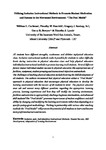Utilizing Inclusion Instructional Methods to Promote Student Motivation and Success in the Movement Environment: "The Pool Model"
| dc.contributor.author | Carleton, WL | en |
| dc.contributor.author | Henrich, TW | en |
| dc.contributor.author | Soukup, GJ | en |
| dc.contributor.author | Bowyer, GR | en |
| dc.contributor.author | Lynch, TJ | en |
| dc.date.accessioned | 2016-10-04T14:45:36Z | |
| dc.date.available | 2016-10-04T14:45:36Z | |
| dc.date.issued | 2016-09-30 | en |
| dc.identifier.other | 1 | en |
| dc.identifier.uri | http://hdl.handle.net/10026.1/5558 | |
| dc.description.abstract |
When physical educators look at a swimming pool they can see several adaptations and modifications that are provided to facilitate the safety and skill level proficiency of different swimmers. Depth markers are prominently posted on the side walls and the deck, signs warn against diving into shallow areas (Figure 1) and teachers and lifeguards constantly observe swimmers to insure safe conduct and activity in the pool area. Lane and rope markers warn swimmers of water depth and where it is safe to dive. Spring boards and diving platforms are available at varying heights to appropriately challenge the different skill levels of swimmers and divers at the pool (Figure 2). Flotation equipment is used by physical educators to accommodate the safe learning and improvement of skills in beginners and low-skill swimmers and that same equipment is also used by teachers and coaches to improve the skills and performance levels of elite swimmers (Figure 3). Other modifications like ramps and lift chairs (Figure 4) are also used by adapted physical educators to accommodate swimmers with physical limitations and to create a more inclusive learning environment at the pool. Properly trained and certified physical educators and lifeguards as well as life-saving equipment are necessary to protect swimmers and provide a safe and enjoyable learning environment. | en |
| dc.format.extent | 1 - 8 (8) | en |
| dc.language.iso | en | en |
| dc.publisher | Department of Human Kinetics and Health Education, University of Lagos | en |
| dc.subject | Inclusion | en |
| dc.subject | Individualised Instructional Methods | en |
| dc.subject | Student Success | en |
| dc.subject | Skill Development | en |
| dc.subject | Adaptation of learning environment | en |
| dc.title | Utilizing Inclusion Instructional Methods to Promote Student Motivation and Success in the Movement Environment: "The Pool Model" | en |
| dc.type | Journal Article | |
| plymouth.author-url | http://www.timothylyncheducation.com/ | en |
| plymouth.issue | 1 | en |
| plymouth.volume | 3 | en |
| plymouth.publisher-url | http://unilag.edu.ng/departmentdetail.php?sno=8&parentid=15 | en |
| plymouth.publication-status | Published | en |
| plymouth.journal | Journal of Research and Contemporary Issues in Human Kinetics and Health Education | en |
| plymouth.organisational-group | /Plymouth | |
| plymouth.organisational-group | /Plymouth/Faculty of Arts, Humanities and Business | |
| plymouth.organisational-group | /Plymouth/Faculty of Arts, Humanities and Business/Plymouth Institute of Education | |
| dcterms.dateAccepted | 2016-01-10 | en |
| dc.rights.embargoperiod | Not known | en |
| rioxxterms.licenseref.uri | http://www.rioxx.net/licenses/all-rights-reserved | en |
| rioxxterms.licenseref.startdate | 2016-09-30 | en |
| rioxxterms.type | Journal Article/Review | en |
| plymouth.oa-location | http://media.wix.com/ugd/842c5e_220d7608f12d472dad6733f3a4732a50.pdf | en |


